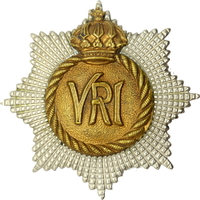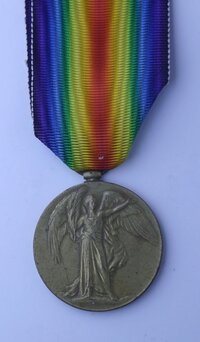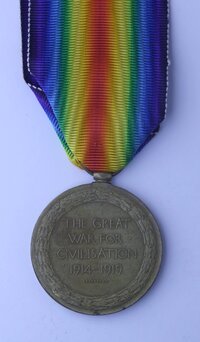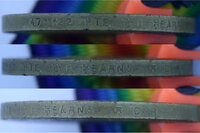
478922 Private Douglas Henry Hearns
The Royal Canadian Regiment
By: Capt (ret'd) Michael M. O'Leary, CD, The RCR
Douglas Henry Hearns was born on 6 Aug 1899 in Victoria, British Columbia. Hearns's family, led by parents Henry (50) and Helen (34), can be found in the 1901 Canadian census. In 1901, one-year-old Douglas is the third of three children with older siblings Jane M. (4) and Hilda H. (3).
Claiming to be 18 years of age, Hearns enlisted with The Royal Canadian Regiment in the Canadian Permanent Force (P.F.) on 12 Jan 1915 at a new regimental station established at Esquimalt, B.C. The RCR had garrisoned company stations in central and eastern Canada since the Regiment was formed in 1883. In 1914, at the outbreak of the First World War, Captain Edward Seely-Smith was in British Columbia en route to an exchange posting in Australia. The declaration of war resulted in Seely-Smith being ordered to remain in Canada, and to establish a new company garrison at Esquimalt. This new location, "L" Company, would perform garrison duties and recruit regimental soldiers throughout the First World War. On enlistment as a P.F. soldier, Hearns was given the regimental number 15102.
Hearns attested for service in the Canadian Expeditionary Force (C.E.F.) with The RCR overseas on 1 Mar 1916. Declaring his age to be 19 years, 8 months, Hearns was described on his attestation paper as a motor launch driver ("mechanic" on his Medical History Sheet). He was 5 feet 8 1/2-inches tall, weighing 112 pounds, with a 33-inch chest, a fair complexion, blue eyes, and brown hair. His religious denomination was Methodist. Hearns identified his father, Henry Hearns, 936 Craigflower Rd, Victoria, B.C., as his next of kin. On attesting for C.E.F. service, Hearns was given the service number 478922.
The first stage of Hearn's journey to the Western Front was a transfer to the Base Depot of The RCR at Halifax, N.S., on 12 May 1916. About six weeks later, on 1 Jul 1916, he sailed from Halifax with the 4th Regimental Draft of RCR Reinforcements. Hearns arrived in England on 6 Jul 1916 and was taken on the strength of The R.C.R. & P.P.C.L.I. Depot at South Caesars Camp, Folkestone.
Commencing July, 1916, Hearns established a monthly Pay Assignment of $15 to be sent to his mother. As a Private in the C.E.F., Hearns was paid $1.00 per day plus an additional ten cents daily field allowance. His pay assignment represented about one-half of his monthly pay. Nellie Hearns also received $20 monthly Separation Allowance, which began in July, 1916. The amount of separation allowance increased to $25 per month in December, 1917, and to $30 in September, 1918.
On 17 Jul 1916, Hearns was charged with "Overstaying leave one day." Found guilty of this minor charge, he was admonished and forfeited one days pay.
Hearns was admitted to Moore Barracks Hospital on 6 Aug 1916. Diagnosed with German Measles, his Medical Case Sheet noted that he had a "Mild case with no unusual symptoms or complications." Despite the lack of severity of symptoms, the risk of further contagion resulted in Hearns' admission to the Isolation Hospital at Folkestone the following day. After two weeks, he was discharged from the Isolation Hospital on 22 Aug 1916 and from Moore Barracks Hospital the next day.
Four days after his return to unit from hospital, on 27 Aug 1916, Hearns was struck off the Strength of The R.C.R. & P.P.C.L.I. Depot and proceeded overseas to The RCR in France. On landing in France, he was taken on the strength of The RCR.
On the day Hearns joined the Regiment, The RCR was in Corps Reserve. Spending the following two weeks in reserve and support roles, and in rest billets, the Regiment did not return to the front line until mid-September, 1916.
The RCR moved into the Reserve battalion position for the Brigade north of Pozieres on 15 Sep 1916. The following day, the battalion advanced to a jumping off position and, at 5:00 p.m. assaulted toward the German positions known as ZOLLERN GRABEN. A report of the action contained in the Regiment's War Diary summarizes the unsuccessful nature of the attack:
"Zero time was 5. p.m. At this hour the Bn. was disposed as follows:- "A" Co. & "D" Co. in FABECK GRABEN, "C" Co. in SUGAR TRENCH, "B" Co. in OLD BRITISH TRENCH. The Artillery Barrage was to have commenced at 4.45 p.m., but according to reports the few shells that went over burst well in rear of the objective and caused practically no damage to the Hun, who was holding his line very thickly. … "A" and "D" Cos. advanced about 75 yds from FABECK GRABEN in the face of extremely heavy rifle and M.G. fire together with considerable artillery fire. The casualties were heavy and the advance was held up about 150 yds from the ZOLLERN GRABEN. … The total casualties as far as can be ascertained amount to 1 Officer killed, 4 wounded and about 279 O.R. killed, wounded or missing."
After holding trenches in the area of the jumping off location for the failed assault, The RCR was relieved and proceeded to bivouacs. The remainder of the month was spent providing working parties and in Corps Reserve. On 2 Oct 1916, The RCR would return to front line trenches at Tara Hill, Hearns would not be with them.
On 2 Oct 1916, Hearns was admitted to No. 10 Canadian Field Ambulance. He was diagnosed with exhaustion and sent to the Corps Rest Station (C.R.S.). After a months at the Rest Station, Hearns was diagnosed with "Immature Neurasthenia," classified Permanent Base (P.B.), and transferred to the Canadian Casualty Assembly Centre (C.C.A.C.) in England. This was the unit where wounded soldiers were assessed for either further treatment or return to duty. On 5 Nov 1916, he was taken in the strength of the C.C.A.C. at Shoreham.
A few days after arriving in Shoreham, Hearns was subject to a Medical Board to assess his current condition and likelihood of return to active service. Recorded in the proceedings of a Medical Board conducted on 7 Nov 1916 was the following: "Disability: Underage. Present Condition: Three months in France, was buried, when in hospital his age was found out." … "result, Permanent Base."
Although Hearns' true age is not recorded in his service record, it is clearly the factor that kept him from returning to The RCR in the field. Born in 1899, He had enlisted with "L" Company in Esquimalt at the age of 15, and reached France and served in the trenches at 16 before being found out. This was likely by his own admission since he was allowed to remain overseas with the C.E.F. If his youth had been discovered due to his parents attempting to have him returned to Canada, that would have been the likely result.
Still belonging to the C.C.A.C. as his parent unit in England, Hearns was attached On Command to the Garrison Duty Depot (G.D.D.) at Shoreham from 10 Nov 1916. Being "On Command" meant that his parent unit did not change although he was employed by the Duty Depot.
On 9 Jan 1917, Hearns went before another Medical Board at Hastings. Again, he was determined to be "Underage" and his medical category was assigned as "A4." This category was for boys who would be fit as soon as they reached 19 years of age.
Remaining in the reinforcement system of reserve units in England, Hearns was attached to the 26th Reserve Battalion at Bramshott on 22 Feb 1917. A few weeks later, on 10 Mar 1917, he was struck off the strength of the C.C.A.C. on transfer to the newly formed Nova Scotia Regiment (N.S.R.) at Hastings.
With the Nova Scotia Regimental Depot (N.S.R.D.), the N.S.R. was part of the new regionally based reinforcement system, with named Depots taking in troops from battalions raised in those areas in Canada and providing reinforcement drafts to similarly designated fighting units. The RCR, having been headquartered in Halifax in the decade before the War, was associated with the N.S.R.D. These Depots also became the parent unit for any soldiers returned to England from their affiliated battalions in France and Flanders.
On 7 Apr 1917, Hearns ceased to be attached to the 26th Reserve Battalion on transfer to the Canadian Forestry Corps. He was subsequently transferred to the 3rd District of the Canadian Forestry Corps (C.F.C.) on 7 May 1917, and then to the 4th District on 1 Sep 1917.
Hearns spent the remainder of the war serving with the Canadian Forestry Corps. He was granted nine days leave commencing New Year's Eve on 31 Dec 1918, returning to duty after 8 Jan 1919. On 18 Feb 1919, he was struck off the strength of the 4th Distict, C.F.C. to the Base Depot, C.F.C., at Southampton. Over the following month he was processed for return to Canada and, on 23 Mar 1919, he embarked on H.M.T.S. Empress of Britain and taken on the strength of District Depot 11, Hastings Park, Vancouver, B.C.
In its edition of 1 Apr 1919, the Victoria Daily Times announced:
"EMPRESS OF BRITAIN PARTY FOR VICTORIA "Large Numbers for Island From Regina and Empress
"The British Columbia Returned Soldier Commission, Parliament Buildings, has been advised by telegram from the O.C. Clearing Depot, St. John, N.B., that the following party from the Empress of Britain arrived there on March 30 and left on the same date for this district: … D.H. Hearns, 926 (sic) Craigflower Road …"
The District Depot managed Hearns' discharge administration. On 7 May 1919, it was recorded at his discharge medical that Hearns was 6 feet 2 1/2-inches tall and weighed 154 pounds. During his service, he had grown six inches and gained 42 pounds.
Douglas Hearns was discharged from the C.E.F. at District Depot, M.D. 11, Vancouver, B.C., on 23 May 1919. he was issued the Class "A" War Service Badge, numbered 304048.
Research into Hearns' later life has revealed little information. On 14 Feb 1920, the Victoria Daily Times published an obituary notice for Miss Jean Mary Hearns, who had died of pneumonia at the age of 23 (or influenza according to a similar notice in the Sidney and Islands Review and Saanich Gazette on 18 Feb 1920). The notices identified one of her surviving siblings as Douglas Hearns of Victoria.
For his service in the C.E.F., Hearns was entitled to receive the British War Medal and the Victory Medal. These were despatched to him at Dollarton, B.C., near Vancouver, on 28 Jul 1922.
An underaged soldier, buried by shellfire on his only tour of the front line.
An underaged soldier, buried by shellfire on his only tour of the front line.' },
![]()
![]() 478922 Private Douglas Henry Hearns
478922 Private Douglas Henry Hearns
An underaged soldier, buried by shellfire on his only tour of the front line.
![]()
![]() 478922 Private Douglas Henry Hearns
478922 Private Douglas Henry Hearns
An underaged soldier, buried by shellfire on his only tour of the front line.
Pro Patria
Visit a randomly selected page in The O'Leary Collection (or reload for another choice):
- The O'Leary Collection; Medals of The Royal Canadian Regiment.
- Researching Canadian Soldiers of the First World War
- Researching The Royal Canadian Regiment
- The RCR in the First World War
- Badges of The RCR
- The Senior Subaltern
- The Minute Book (blog)
- Rogue Papers
- Tactical Primers
- The Regimental Library
- Battle Honours
- Perpetuation of the CEF
- A Miscellany
- Quotes
- The Frontenac Times
- Site Map
QUICK LINKS
The O'Leary Collection—Medals of The Royal Canadian Regiment
Newest additions:
![]()
![]() SB-12725 Private Henry "Hank" Ard
SB-12725 Private Henry "Hank" Ard ![]()
WIA at Hill 187, Died of Wounds in Japan
![]()
![]() 2355331 Lance Corporal Albert Lorking
2355331 Lance Corporal Albert Lorking
Wounded in action, later a War Amps representative.
![]()
![]() 4334 / 477996 Pte Isaac Hamilton Wilcox
4334 / 477996 Pte Isaac Hamilton Wilcox
Permanent Force, South Africa, and C.E.F.
![]()
![]() 477019 Private Harold Ashcroft
477019 Private Harold Ashcroft
Transferred to the Tunnelers.
![]()
![]() 734231 Private Clark D. Thompson
734231 Private Clark D. Thompson ![]()
The older Thompson brother, killed in action.
![]()
![]() 733849 Private Norman Parker Thompson
733849 Private Norman Parker Thompson
The younger Thompson brother; post-war service in the Special Guard.
![]()
![]()
![]() A305 / 400305 Private Andrew Walker
A305 / 400305 Private Andrew Walker ![]()
"Previously reported Wounded, now Killed in Action."
![]()
![]() 823298 Pte Thomas Patrick Steele, M.M.
823298 Pte Thomas Patrick Steele, M.M. ![]()
… for gallant conduct in the field …
![]()
![]() P13066 Sergeant Harold Thompson
P13066 Sergeant Harold Thompson
Instrumental Soloist for over 20 years of Canadian Army service.
![]()
![]() 9609 / 477728 Private Albert Edward Piper
9609 / 477728 Private Albert Edward Piper
"Arrived from England as a STOWAWAY …"




